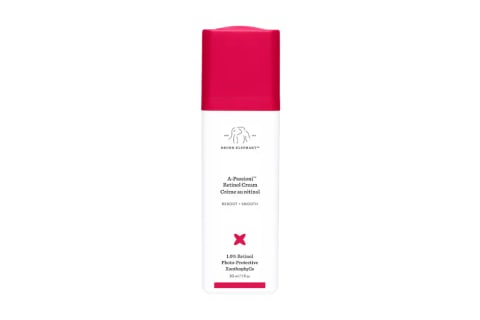Advertisement
7 Expert-Approved Ways To Tighten The Skin On Your Face Naturally


While there's nothing wrong with wrinkles (remember—they're a sign you've lived a long life!), sometimes sagging skin can breed insecurities. There are plenty of procedures out there that can help the skin appear younger, but you don't have to take that route if you don't want to. Plus, they won't do much for the health of your skin long term.
We asked experts for the best noninvasive remedies to tighten sagging skin on the face. To follow, their professional advice and what causes loose skin in the first place. Let's get into it.
What causes loose and sagging skin on the face?
"When thinking about the skin in layers and what causes skin aging over time, we examine from the bottom up what levels of the face get affected by aging," board-certified dermatologist and director of cosmetic dermatology at Montefiore Einstein Advanced Care Kseniya Kobets, M.D., tells mbg.
As you age, your face may slowly lose volume around the bones of the cheek, forehead, temples, and jawline. "This is our infrastructure, or scaffolding, that holds up the fat, collagen, and skin," Kobets says.
"When this diminishes, it causes hollowness of cheeks, under-eye, and temples but also the lower part of the face begins to sag and droop in the jowls or marionette lines," she explains. The latter marionette lines refer to the vertical lines around the mouth.
As you begin to age, sagging skin is inevitable, board-certified dermatologist and founder of MMSkincare Ellen Marmur, M.D., tells mbg. "But other factors such as diet, sun exposure, and sleep deprivation can contribute to it," she adds.
All of this to say: Aging skin is a natural process that cannot (nor should) be avoided. However, there are external factors that contribute to accelerated skin aging. What's more, these factors like lack of sleep, smoking, chronic stress, etc., aren't good for the health of your skin or your body.
Summary:
How to tighten skin on the face
Now that you know why skin begins to sag, let's dive into the best ways to tighten the skin. All of the points below are not only ideal for treating already-aged skin but also essential for preventing accelerated aging.
So, keep these in mind whether you've begun to notice sagging skin or not:
Use a microcurrent tool
"Microcurrent is a very tiny electrical current that mimics your body's own natural pulses," biomedical engineer and holistic skin care expert Pooja Johari, M.S., founder of 7E Wellness, once told mbg.
"What that means is our brains use currents to communicate through our neurological pathways, where it's constantly sending signals. What we're doing with this technology is mimicking those currents and delivering them to our facial muscles," she added.
Essentially, microcurrent tools work through the production of adenosine triphosphate (ATP), or a molecule that's naturally produced in the body and acts as an energy currency.
Your body (skin and muscles included) uses it as part of its regenerative process, creating more collagen, elastin, etc. What's more, these tools help strengthen the facial muscles under the skin. This, in turn, will help improve facial contour and skin tone and reduce wrinkles.
"Microcurrent devices can be highly effective," Marmur says, but only when used consistently. So pick up a microcurrent tool and make it part of your daily routine—here's our curated list of the six best options on the market right now.
Summary
Add collagen to your daily menu
"Collagen is what gives our skin a tight and taut look, but as we age we begin to lose natural collagen," board-certified dermatologist and assistant clinical professor of dermatology at Mount Sinai School of Medicine Jeannette Graf, M.D., tells mbg.
One way to boost your natural collagen production is through collagen supplementation. However, not all supplements are created equal. "While there may be some truth to collagen supplements stimulating collagen production, it's important to not skimp on quality when buying collagen supplements," Graf emphasizes.
She recommends looking for hydrolyzed collagen peptides. While collagen research may be somewhat new, most of the promising results have been seen with this form of collagen supplement.
More specifically, the research shows that these collagen peptides are able to support skin elasticity and dermal collagen density1. What's more, "Amino acids in collagen supplements might increase hydration levels in the skin," Graf adds. Here's a list of the very best collagen supplements, all backed by a nutrition Ph.D. if you want to start looking.
Summary
Practice gua sha
Gua sha, also known as jade scraping, uses a small stone scraping tool to increase circulation. While this is certainly a worthy benefit on its own, this practice may also help with skin aging.
One study showed that facial rolling—which lends a similar effect to gua sha—for only five minutes a day improved blood flow to the face2, resulting in better skin quality and smoother skin over time. In another, patients claimed feeling tighter, more supple skin2 after regular massages.
However, gua sha is not a one-and-done kind of practice—you must be consistent to see results. Plus, using this tool is not necessarily intuitive, so you should take a few minutes to learn how to use your gua sha before touching it to the skin.
For a quick breakdown of best practices and to learn more about why gua sha works, check out this story.
Summary
Microneedling treatment
Microneedling is essentially the process of pricking the skin with tiny, sterilized needles. When these needles pierce the skin, they create tiny punctures.
"This ultimately leads to the triggering of our body's wound-healing process and the release of growth factors that stimulate cell regeneration and the production of collagen and elastin," board-certified dermatologist Michelle Henry, M.D., FAAD, once told mbg.
As you now know, triggering collagen and elastin production is the goal when it comes to rejuvenating the skin and making it more taut.
Kobets notes that microneedling is another worthy investment for skin tightening—however, it should be done by a professional, not at home. DIY-style dermarollers can be dangerous and difficult to use correctly. Plus, you'll see greater results when you visit a professional for this treatment, as their needles pierce deeper into the skin.
Not to mention, in-office microneedling tools are often used in conjunction with other methods like LED light therapy (more on that in a bit)—this means you'll get even more benefits like improvement in tone, texture, etc.
Summary
Use retinol
Topical retinol serums and creams are another option for reviving sagging skin. "Retinol binds to retinoid receptors within skin cells," board-certified dermatologist Zeichner once said. This "activates genes that upregulate collagen production," he added.
This effect was observed in a small human study, where retinol treatment stimulated collagen production3 in mature skin, helping decrease the appearance of wrinkling.
Retinol comes in many forms, with over-the-counter and prescription-grade products available. Depending on your unique skin type and goals, you may be a candidate for stronger prescription products, but you'll have to consult your dermatologist first.
If you want to start using retinol ASAP, opt for one of these expert-approved retinol serums and use it in conjunction with a hydrating routine to prevent dryness and irritation. You may even opt for the skin cycling method, using retinol every few days—you can read all about that here.
Summary
Invest in an LED light therapy device
LED light therapy devices are one other approach. "There are some studies evaluating the use of red light therapy for increasing collagen and potentially elastin production as well with a demonstrable increase in collagen density," board-certified dermatologist Erum Ilyas, M.D., MBE, FAAD, said about the devices.
In fact, one study found that patients receiving red light therapy on their face twice a week for 30 total sessions experienced improved skin complexion4, skin tone, skin smoothness, and collagen density (as measured with an ultrasonographic test).
In fact, the study included some before-and-after pictures4, which are pretty impressive. A possible explanation for the role of red light therapy on collagen production is because of the photobiomodulation mechanism. "This means that the light stimulates different pathways in cells that can trigger different outcomes," Ilyas explained.
Kobets agrees, stating that there is "robust science-based evidence for the LED devices that incorporate red light and infrared to stimulate collagen in the convenience of your own home." However, you'll want to do your own research to find a trustworthy device—here are a few A+ options to get you started.
Summary
Prioritize sleep
Sleep is often overlooked in the beauty space, but it's vital to maintaining healthy skin at any age—and research backs up this claim.
Losing sleep increases cortisol (the stress hormone), which can break down collagen over time—research has demonstrated a link between shut-eye and collagen production5, which is why many experts consider sleep a vital part of any "anti-aging" skin routine.
So do your best to get a full seven to nine hours of sleep when you can. If you need some tips to fall asleep faster and get better quality sleep, this guide is for you. Plus, check out our favorite natural sleep aids.
Summary
Best skin tightening products
FAQ
How can you tighten skin without surgery?
The best non-invasive ways to tighten skin include using microcurrent devices, gua sha or jade rollers, retinol, LED light therapy, microneedling treatment, and prioritizing sleep.
What vitamins help tighten loose skin?
Loose skin is caused by a lack of collagen and elastin production, which happens naturally as you age. Consider adding a collagen supplement to your routine, as well as vitamin C, as the latter is essential for collagen production to take place.
Can facial exercises tighten the skin?
The key to making sagging skin tighter is to stimulate collagen production. You can do this by using gua shas, jade rollers, microcurrent devices, LED light therapy devices and ingesting hydrolyzed collagen peptides.
The takeaway
Aging is a beautiful thing, but sometimes sagging skin can make you feel insecure. The best noninvasive ways to tighten your skin include using microcurrent devices, collagen supplements, gua sha or jade rollers, microneedling, retinol, LED light therapy, and getting enough sleep. If you're looking for a full skin care routine for aging skin, this guide will help you put together an A+ regimen from start to finish.
5 Sources
- https://jddonline.com/articles/dermatology/S1545961619P0009X
- https://www.sciencedirect.com/science/article/pii/S0965229918306423?via%3Dihub
- https://jamanetwork.com/journals/jamadermatology/fullarticle/412795
- https://www.ncbi.nlm.nih.gov/pmc/articles/PMC3926176/
- https://www.nature.com/articles/s41556-019-0441-z
Watch Next
Enjoy some of our favorite clips from classes
Enjoy some of our favorite clips from classes
What Is Meditation?
Mindfulness/Spirituality | Light Watkins
Box Breathing
Mindfulness/Spirituality | Gwen Dittmar
What Breathwork Can Address
Mindfulness/Spirituality | Gwen Dittmar
The 8 Limbs of Yoga - What is Asana?
Yoga | Caley Alyssa
Two Standing Postures to Open Up Tight Hips
Yoga | Caley Alyssa
How Plants Can Optimize Athletic Performance
Nutrition | Rich Roll
What to Eat Before a Workout
Nutrition | Rich Roll
How Ayurveda Helps Us Navigate Modern Life
Nutrition | Sahara Rose
Messages About Love & Relationships
Love & Relationships | Esther Perel
Love Languages
Love & Relationships | Esther Perel
-v1646695196476.jpg?1148x800)






















